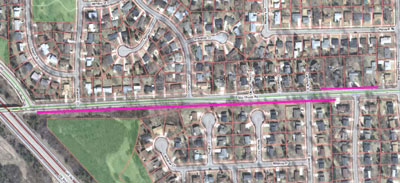Sidewalks: Repair, Build, Shovel
Local government doesn’t get more pedestrian than sidewalks.
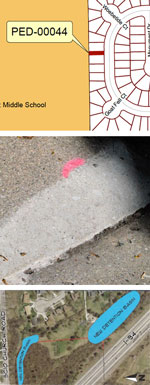
Top: Example of a cross-lot walkway, leading from street to school. Middle: Sidewalk that was cut flush funded by the city’s sidewalk repair millage. Bottom: Recommended detention ponds in Eisenhower Park near the proposed Scio Church sidewalk.
Yet these existing and future slabs of concrete are themselves a constant topic of confusion and controversy: Who’s responsible for repairing the busted slab in front my house? Who’s supposed to shovel snow off the sidewalk in the winter?
Sidewalks also connect up to other equally important if also dull components of local governance – like stormwater management and public art.
So here’s a quick rundown of some specific sidewalk-related issues that the Ann Arbor city council will be considering.
The council’s agenda for Monday, Oct. 7, includes an item on the definition of sidewalks. If an existing walkway meets the definition of a “sidewalk,” then the city bears responsibility for its repair for the duration of the sidewalk repair millage. All other things being equal, the adjacent property owner would be responsible for snow removal in the winter.
The Oct. 7 agenda item focuses on walkways that aren’t really on the “side” of anything – walkways that connect a street to a park or school, or that connect two parallel streets. The city calls them “cross-lot” walkways. If such walkways were added into the definition of “sidewalk” – as the city council is contemplating – then the city would be responsible for repair. That’s a result welcomed by property owners. But it would put the burden for snow removal on those property owners – a less welcome result. That was the sentiment that led the council to postpone final consideration of a change to the definition of “sidewalk” three months ago, on July 1, 2013.
So on Oct. 7, the council will be asked to consider a different approach to that definitional change – one that would allow the so-called “cross-lot” paved pathways to qualify as sidewalks under the city’s ordinance, but not trigger a winter maintenance requirement for adjacent property owners.
The fresh look would mean that the council’s possible action on Oct. 7 would be considered only an initial approval of the ordinance change. Final enactment of the change would require a second vote at a subsequent council meeting. If approved, the ordinance would allow cross-lot paths to be repaired under the city’s sidewalk repair program – funded through the five-year millage approved by Ann Arbor voters in November 2011. That program is noticeable to residents in the form of pink markings that appear on sidewalk slabs – an “R” for replace and a “C” for cutting an out-of-alignment section so that it lines up flush with the next slab.
The millage can pay for repair or replacement of existing slabs of sidewalks, but not for the construction of new sidewalks. So that millage money isn’t available to build a new stretch of sidewalk along the south side of Scio Church Road (or to fill in a smaller gap on the north side) – a section of sidewalk that residents have petitioned the city to build. The petition for a sidewalk there is based on several considerations, including a desire to connect to amenities west of I-94, like the Ice Cube, Wide World of Sports and the Ann Arbor District Library’s Pittsfield branch. It’s also seen as a pedestrian safety issue, because the lack of a sidewalk on one side of the road could induce pedestrians to cross the road at places where motorists don’t expect pedestrians to cross.
The city council authorized $15,000 of general fund money for the study of alternatives along that stretch – alternatives that were presented at a meeting held on Sept. 18 at Lawton Elementary School and attended by about two dozen people. Next up for the city council, likely on Oct. 21, will be a request for a design budget, so that costs of the project can be estimated with more precision.
Among the alternatives that were considered, but not pursued in much detail, was construction of a pathway through Eisenhower Park. That’s where the Washtenaw County water resources commissioner is now recommending that a pair of detention ponds be constructed – to help mitigate overland flooding in the area. That recommendation was presented to a group of about 80 neighbors on Sept. 30 – also held at Lawton Elementary School.
And a fence that that might need to be constructed along the proposed Scio Church sidewalk – to prevent people from falling down the steep incline – received a glancing mention at a recent meeting of the Ann Arbor public art commission. A proposal to fund a public art project that would be integrated into the fence was tabled by the commission at its Sept. 25, 2013 meeting.
Cross-lot Sidewalks
The city council had given initial consideration to the change in the definition of a sidewalk at its June 3, 2013 meeting. When the final decision came before the council on July 1, 2013, councilmembers heard from residents like John Ohanian and Miranda Wellborn Eleazar, whose properties abut cross-lot walkways.
Under the ordinance change the council considered that evening, the city’s sidewalk repair millage could be used to fix any defects in the slabs – but Ohanian and Wellborn Eleazar would have to shovel the walkway during the winter. That concern led to a postponement by the council until Oct. 7.

This cross-lot path was described by John Ohanian at the city council’s July 1, 2013 meeting as one that he’d become responsible for shoveling if the city adopted the change in the definition of sidewalk.
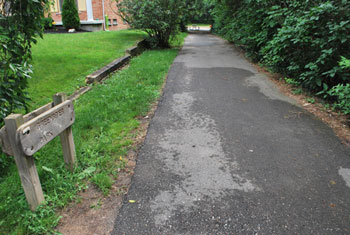
This is the path – looking east from Frederick and Middleton into Greenbrier Park – that abuts Ohanian’s property.
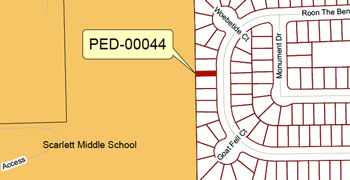
This is the cross-lot path that the Eleazars would become responsible for shoveling, if the change to the definition of sidewalk is adopted.

The cross-lot path that leads from Roon the Ben in the Turnberry neighborhood to the ballfields for Scarlett-Mitchell schools. A pending ordinance change could eventually place responsibility for capital repairs on the city, but give adjacent property owners the responsibility of shoveling snow.
On Oct. 7, the council will be asked to consider a revised approach to these cross-lot walkways. The ordinance would still be changed to include them in the definition of a “sidewalk” – so repairs could be paid for with sidewalk millage money. But the ordinance change would not assign responsibility for snow clearance to the adjacent property owners. The staff memo accompanying the Oct. 7 ordinance proposal estimates that the total city cost for repairs and snow clearance for 34 cross-lot walkways would be $7,000 – $5,100 for plowing and $1,900 for repair.
The 34 cross-lot walkways that would be affected by the ordinance change would need to be accepted by the city for public use, in order for the ordinance language to apply. That’s a companion resolution the council will also need to approve.
Because the change to the ordinance is substantively different from the approach the council had previously given initial approval, any action taken on Oct. 7 by the council would be considered another initial approval, according to the staff memo. For the ordinance change to be enacted, it would need a second, final vote by the council at a subsequent meeting.
Construction of New Sidewalks
As part of the current fiscal year 2014 budget approved on May 20, 2013, the city council included $75,000 for a sidewalk gap prioritization study.
But before and after the adoption of the budget, the city council approved money related to specific gaps – for an alternative study or actual design work. The council has made such allocations on three occasions in the last year, starting on Nov. 19, 2012. That’s when the council approved $15,000 for an alternatives analysis of a stretch along Scio Church Road, west of Seventh Street and east of I-94.
Residents who live on and near Scio Church had submitted a petition asking for the construction of a sidewalk along the south side of the road. That petition prompted the city council allocation of money for an alternatives analysis.
For some of the other specific sidewalk projects, the council allocated a design budget. For Scio Church Road, the alternatives analysis comes first, because the design won’t be straightforward – due to the physical challenges involved, related to the sloping terrain.
In fact, those physical challenges were cited by city senior project manager Liz Rolla at the Sept. 18 Lawton Elementary School meeting as one possible reason why the sidewalk gaps exist along that stretch. One resident, who described herself as new to the area, asked for a nutshell explanation of why, on the south side of the road, there’s a sidewalk heading west until halfway between Delaware and Churchill, “and then there’s nothing.”
In addition to the physical challenges, Rolla ventured that when the sidewalks were constructed, the perceived need for pedestrians to go west all the way to I-94 and beyond was not as great. Facilities like the Ann Arbor Ice Cube, Wide World Sports Center and the Pittsfield branch of the Ann Arbor District Library, she said, were from her perspective relatively new – but for her kids, they seem like they’d been there forever. Those facilities create a need for pedestrian travel westward.
One resident at the meeting traced the problem to the city’s failure to install proper sidewalks when the land was annexed from Pittsfield Township, citing the city’s requirements that regulate how public sidewalks and driveway entrances are constructed. He was reluctant to see just the gap on the south side of Scio Church addressed, reasoning that the city should provide sidewalks on both sides of the street.
An outcome of the Sept. 18 meeting is that the staff will request that the city council provide money for a design budget – for both sides of Scio Church, including the shorter gap on the north side of the street. That request is supposed to be on the council’s Oct. 21 agenda, according to the staff summary of the meeting. [.pdf of Sept. 18, 2013 staff summary of Lawton Elementary School sidewalk meeting]
The sentiment of the attendees at the Sept. 18 meeting was that – while they very much wanted to see sidewalks constructed to eliminate the gap – they were reluctant to see what they viewed as unreasonable costs imposed on adjacent property owners, who would bear some of the project’s cost. That cost is typically imposed by the city through a special assessment of properties that front the sidewalk. Because much of the south side of Scio Church, where the proposed sidewalk would be constructed, is adjacent to city parkland or the rear of cul-de-sacs, few property owners would be special assessed.
One resident who attended the Sept. 18 meeting, and whose property would be special assessed, indicated he had not signed the petition, nor had he known about it: “The funding of this is a very, very big deal to me,” he said. “This is money that I’m hoping that my son can use to go to college. A portion of that would have to go to this project if this property is assessed.”
Rolla and city engineer Nick Hutchinson, who also attended the meeting, stressed throughout the discussion that the numbers they’d provided should not be seen as the amounts that residents would have to pay – because the estimates were only very rough, and not all elements of the project would be subject to special assessment. Retaining walls, for example, would likely not be assessed, Hutchison indicated.
Another factor reducing the potential burden to local property owners is the possibility that federal surface transportation funds could be used to offset part of the cost. But Hutchinson stressed that even if the city was successful in obtaining such federal funds – which are administered through the state of Michigan – a 20% local match would still be required.
Residents at the meeting appeared sensitive to the potential financial burden that just a few residents might have to bear. The resident who had organized the petition to the city reported that he got the feeling from talking to the neighborhood that there are ways to share the burden of the assessment – either formal or informal ways among those who wouldn’t ordinarily be special-assessed. Speaking for himself, he said, “I’m eager to do it.” Another resident chimed in, quickly: “I was just going say the same thing. I am perfectly willing to chip in,” she said. “I definitely want sidewalks,” she continued. “Me, too!” added another. “Yes, I am in favor of that as well,” another resident said.
Rolla told attendees that the preliminary conversation with the city attorney’s office had indicated that a formal arrangement of those neighbors – people contributing to the sidewalk who wouldn’t ordinarily be specially assessed – would best be done through a single point of contact for a group of property owners, like a neighborhood association.
The dollar figures that residents reacted to were the following for the three numbered alternatives – as the option of building a pathway through Eisenhower Park wasn’t pursued in any detail. Even the staff’s preliminary consideration led to the conclusion that the park path option would be cost prohibitive.
- Build Path through Park
Challenges: Slope issues (Americans with Disabilities Act); it would require removal of many
trees; it’s isolated with no streetlights; requires crossing of creek.
Cost: Cost prohibitive. Not pursued. - Pedestrian Crossing Island near Churchill
Estimated cost: $56,000
Funding mechanism: In the past, pedestrian islands have been funded in conjunction with major road reconstruction projects, safety funds, street millage, MDOT. Not specially assessed to residents.
Responsibility for snow shoveling: City of Ann Arbor - Fill-in North Side Gap
Requires: Grading, retaining wall, tree removal.
Rough estimated cost: It’s about 370 feet long, with estimated cost of $90,000, which means about $245 per lineal foot.
Funding mechanism: In the past, this type of project is funded by special assessment to fronting properties or installed by the property owner.
Responsibility for snow shoveling: Property owners who have property that fronts the sidewalk. - Extend South Sidewalk to Maple
Requires: Grading, retaining wall, tree removal, replacement of guardrail, addition of curb and gutter and fence.
Rough estimated cost: It’s about 2,000 feet long, with estimated cost of $360,000, which is about $180 per lineal foot.
Funding mechanism: In the past, special assessment has been used, but only a few of the properties along the stretch could be special assessed, as the rear of cul-de-sacs would not be subject to the assessment. Federal surface transportation funds could be used, requiring a 20% local match.
Responsibility for snow shoveling: Property owners who have property fronting the sidewalk (corner lots). This does not include cul-de-sac lots with no connection to the sidewalk. The city would plow the sidewalk where no other adjacent property owner is responsible
Next up for the city council, on Oct. 21, will be a request for a design budget, so that costs of the project can be estimated with more precision.
Detention Ponds, Art
The project extending the Scio Church sidewalk to Maple Road includes a fence – to keep pedestrians from falling down the embankment. That fence was the subject of deliberations by the Ann Arbor public art commission at its Sept. 25, 2013 meeting.
The art commission tabled the proposal. [.pdf of AAPAC's intake form for the Scio Church fence] Typically the city would, at this kind of site, install a standard kind of chain link fence. But Craig Hupy – the city’s public services area administrator – had previously told the public art commission that there might be an opportunity for something more creative, if AAPAC wanted to explore that possibility. The AAPAC budget for the tabled fence enhancement was recommended to be between $40,000 and $80,000 from the remaining Percent for Art street funds.
Those funds won’t be replenished after they’re spent, because the city has ended the Percent for Art approach to funding public art. In the future, public art funding will come from partnerships, fundraising and any money that the city council allocates to “enhance” capital projects. The remaining Percent for Art funds are supposed to be spent on projects that are tied thematically or physically to the funds of origin.
Although the Scio Church fence art project was tabled on Sept. 25, the city’s public art administrator, Aaron Seagraves, told art commissioners he could put together a more detailed proposal for AAPAC’s October meeting.
The end of the sidewalk near Maple, where the fence and a guardrail would need to be reconstructed, received comment at the Lawton Elementary School meeting of Sept. 18 – in connection with a pair of potential detention ponds in the adjacent Eisenhower Park. The Washtenaw County water resources commissioner is recommending that the ponds be constructed there as part of recommendations for mitigating flooding in the area.
At the Sept. 18 meeting, one resident suggested that the earth that would need to be excavated to create the detention ponds could be used to help soften the angle of the slope from Scio Church Road down into the park, possibly helping to meet the challenge of sidewalk construction there. The same resident expressed desire for the sidewalk construction to be coordinated with the detention pond construction, so that the city does not construct a new sidewalk, fence and guardrail, and then tear it out to gain access to Eisenhower Park for the detention pond project.
While the sidewalk construction project could be undertaken in late 2014, the detention pond probably entails a longer timeline. The final report from the upper Mallets Creek stormwater study isn’t due until early 2014. And from that point, the recommendations would need to be adopted into the city’s capital improvements plan, which is the purview of the city planning commission. And after that, the city council would need to decide whether to approve funding allocations for any or all of the recommended projects. [For previous coverage of that project, see: "County Gets Info on Flooding, Shares Options"]
Those recommendations, however, have been developed and modeled. They were unveiled at a meeting on Sept. 30, 2013 – also held at Lawton Elementary School. Although the three proposed stormwater facilities were described as “alternatives,” project manager Harry Sheehan, who’s managing the project in the water resources commissioner’s office, indicated that all three projects are being recommended:
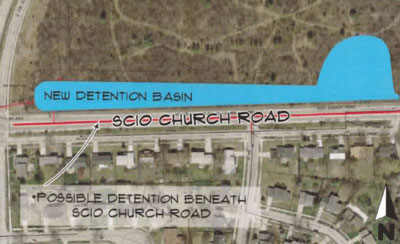
Proposed Pioneer High School detention pond. Cost estimate: $1.2 million. Surface area: 2.8 acres. Total volume: 400,000 cubic feet.
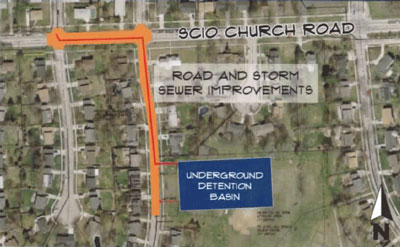
Proposed Lawton detention pond. Cost estimate: $5.15 million. Surface area: 1.1 acres. Total volume: 280,000 cubic feet.
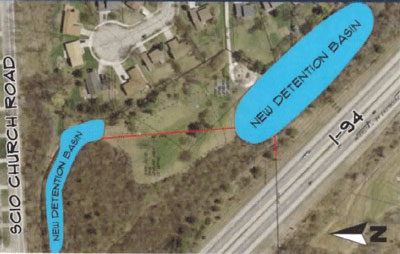
Proposed Eisenhower Park detention ponds. Cost estimate: $2.1 million. Surface area: 2.5 acres. Total volume: 470,000 cubic feet.
At the Sept. 30 meeting, the effect of each project on the mitigation of flooding was presented as modeled for the March 15, 2012 storm, which had resulted in significant overland flooding in the Landsdowne neighborhood.
In the animated .gif below, which loops continuously, the first frame indicates the March 15, 2012 flooded areas in black. The next three frames show the modeled cumulative effect of adding each of the proposed stormwater detention facilities. That is, the maps show what the flooding would have been like, if the proposed stormwater detention facilities had been in place on March 15, 2012.
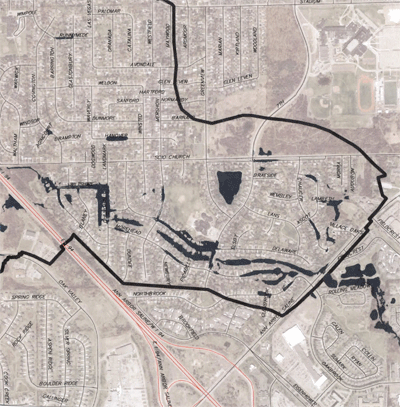
Maps by Spicer Group, the engineering consultant for the upper Mallets Creek stormwater study. Scans and animation by The Chronicle.
The Chronicle is like a sidewalk – because we can’t survive without concrete (financial) support. The kind of support we hope you’ll provide is through voluntary subscriptions. Those voluntary subscriptions support our coverage of public bodies like the city of Ann Arbor. Click this link for details: Subscribe to The Chronicle. And if you’re already supporting us, please encourage your friends, neighbors and colleagues to help support The Chronicle, too!




